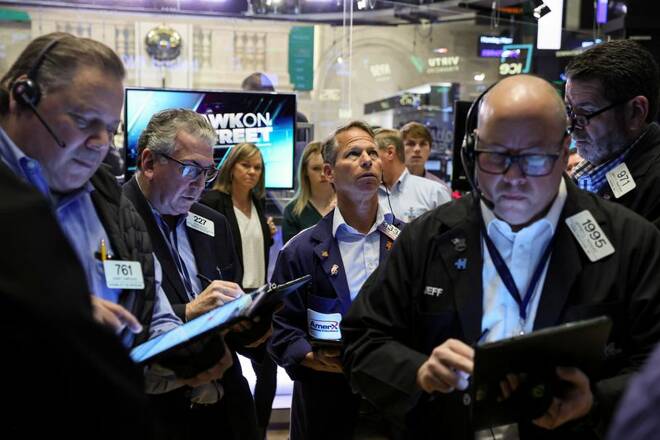Advertisement
Advertisement
Marketmind: Bank stress, bond volatility and disinflation
By:
A look at the day ahead in U.S. and global markets from Mike Dolan
A look at the day ahead in U.S. and global markets from Mike Dolan
The explosion of banking stress has reshaped the entire U.S. interest rate map, wiping expectations of further Federal Reserve rate hikes off the table and sending U.S. Treasury bond volatility to its highest since 2009.
The release of February’s U.S. consumer price inflation report later on Tuesday had until a few days ago promised to be the biggest market mover of the week – but now it may prove to be something of a sideshow to a wider unfolding drama.
Despite weekend moves by the Fed and other regulators to protect depositors at the failed Silicon Valley Bank (SVB) and Signature Bank, and Monday’s assurances from U.S. President Joe Biden that savings in the wider system were safe, bank stocks continued to fall in the United States and around the world.
Major U.S. banks lost around $90 billion in stock market value on Monday, bringing their loss over the past three trading sessions to nearly $190 billion. Regional U.S. banks were hit the hardest, with shares of First Republic Bank diving more than 60% as news of new financing failed to calm investors and credit rating firm Moody’s reviewed it for a downgrade.
Banking stocks in Asia extended declines on Tuesday, with Japanese firms hit particularly hard. After falling almost 6% on Monday, including a 13% drop in Germany’s Commerzbank and a near 10% fall in Credit Suisse, Europe’s main banking index was down another 1% again on Tuesday too.
But the implications of this sudden bout of financial instability – and its potential economic and policy fallout – were most clearly seen in the interest rate and bond markets.
The extraordinary volte-face has futures markets doubt whether the Fed will raise rates at all next week – pricing less than a 50% chance of a quarter point hike compared to the half-point rate rise that was fully priced only a week ago.
More striking is the fact that those same markets now suspect the whole Fed tightening cycle may be over, pricing peak rates at just 4.71% – below the upper band of the current target range of 4.50-4.75% and almost a percentage point below ‘terminal rate’ assumptions only last week.
What’s more, futures also price almost a full percentage point of rate cuts between now and the end of the year. Implied terminal rates for the European Central Bank and Bank of England have been dramatically scaled back too – though one or two further hikes are still priced for those central banks.
Although it’s regained some ground today, the dollar has weakened against the euro, pound and yen this week.
But the Fed rethink has led to seismic action on the U.S. Treasury market, with the biggest drop in 2-year Treasury yields on Monday since the stock market crash of 1987.
At a trough of 3.83% early on Tuesday, those 2-year yields hit their lowest since September last year before rebounding to just back above 4%. As 10-year yields nudged back above 3.5%, a re-steepening of the deeply inverted 2-10 year yield curve – for many a culprit in the onset of banking troubles – stalled.
The scale of the bond gyrations was captured in a surge in the MOVE index of implied Treasury market volatility to its highest since 2009 – exceeding the most stressful periods around the 2020 pandemic and the 2018 repo market shock.
Credit spreads in the corporate bond markets have also widened sharply as investors fear an economy-wide tightening of borrowing standards and financial conditions. Indices of U.S. high-yield ‘junk’ bonds fell to their lowest for the year.
To the extent that this shock to the system hits business borrowing, confidence and hiring plans, the Fed will likely want some time to assess the fallout at least. It would certainly think twice about tightening policy again into this level of financial stress and bond market upheaval.
Recriminations among oversight agencies as to why SVB’s problems were not spotting well in advance are likely to mount – with the Fed’s remit for maintaining financial stability likely clashing with its low inflation and full employment mandates.
The Fed said late Monday it would be conducting a review of the supervision and regulation of SVB, and Chairman Jerome Powell demanded a “thorough, transparent, and swift review” by Vice Chairman for Supervision Michael Barr by May 1.
In one of the first public appearances by a Fed policymaker since the crisis, Fed Board Governor Michelle Bowman is scheduled to speak later on Tuesday.
The February consumer price report due before then – much like last week’s employment numbers – may already be out of date as a temperature gauge of the economy going forward.
Key developments that may provide direction to U.S. markets later on Tuesday:
* US Feb Consumer Price Index, NFIB Feb small business survey, Cleveland Fed Feb CPI
* US Federal Reserve Board Governor Michelle Bowman speaks
* ECOFIN of European Union finance ministers meets in Brussels
* US corp earnings: Lennar
![]()

![]()
(By Mike Dolan, editing by Susan Fenton mike.dolan@thomsonreuters.com. Twitter: @reutersMikeD)
About the Author
Reuterscontributor
Reuters, the news and media division of Thomson Reuters, is the world’s largest international multimedia news provider reaching more than one billion people every day. Reuters provides trusted business, financial, national, and international news to professionals via Thomson Reuters desktops, the world's media organizations, and directly to consumers at Reuters.com and via Reuters TV. Learn more about Thomson Reuters products:
Did you find this article useful?
Latest news and analysis
Advertisement
